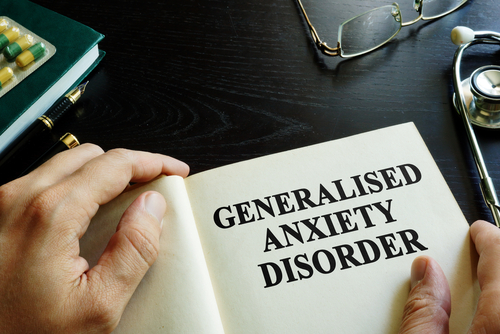
Generalized anxiety disorder (GAD) is listed in the Diagnostic and Statistical Manual of Mental Disorders, Fifth Edition (DSM-5) as a mental illness. Mental Health America explains that GAD “is characterized by six months or more of chronic, exaggerated worry and tension that is unfounded or much more severe than the normal anxiety most people experience.” The diagnosis process for GAD typically begins with undergoing a physical exam along with complete medical history. There is currently no laboratory test or scans used to detect or diagnose a generalized anxiety disorder. There are, however, some tests (e.g., blood tests) that could be used in the diagnosis process to check for any other underlying conditions that may be causing symptoms.
If no signs of physical illness are determined, the process continues with an additional assessment conducted by a mental health professional that specializes in diagnosing and treating mental illnesses (e.g., psychiatrist, psychologist, etc.). The American Family Physician explains that diagnosing GAD “requires a broad differential and caution to identify confounding variables and comorbid conditions.” Generalized anxiety disorder is known as a differential diagnosis. A differential diagnosis implies that there are other possible diagnoses, and requires the diagnostician to differentiate between these possibilities to determine the actual diagnosis and appropriate treatment plan. The mental health professional will ask in-depth questions about one’s reported symptoms (e.g., how long they last, how intense they are, etc.), how the symptoms interfere with one’s daily life, will make observations of one’s attitude and behavior, and may use psychological questionnaires such as the Hamilton test or the GAD-7 screening tool to help determine a diagnosis.
DSM-5 Diagnostic Criteria
The DSM-5 outlines specific criteria to help professionals diagnose a generalized anxiety disorder. When assessing for GAD, clinical professionals are looking for the following, provided by the Anxiety and Depression Association of America:
- The presence of excessive anxiety and worry about a variety of topics, events, or activities that presents more frequently than not for at least six months.
- The worry is experienced as very challenging to control. The worry in both adults and children may easily shift from one topic to another.
- The anxiety and worry are accompanied by at least three of the following physical or cognitive symptoms:
- Edginess or restlessness
- Tiring easily; more fatigued than usual
- Impaired concentration or feeling as though the mind goes blank
- Irritability (which may or may not be observable to others)
- Increased muscle aches or soreness
- Difficulty sleeping (due to trouble falling asleep or staying asleep, restlessness at night, or unsatisfying sleep)
These symptoms must be unrelated to any other medical conditions and cannot be explained by a different mental disorder or by the effect of substance use, including prescription medication, alcohol, or recreational drugs. The diagnostic criteria are somewhat different for adults and children. An adult is diagnosed with a generalized anxiety disorder when at least three of the above symptoms persist for a minimum of six months. In younger people, however, only one symptom is needed for diagnosis, provided it has been exhibited somewhat regularly, spanning over a period of six months. The above criteria differentiate GAD from normal bouts of anxiety and/ or worry that may manifest from a specific set of stressors or for a more limited period.
The information above is provided for the use of informational purposes only. The above content is not to be substituted for professional advice, diagnosis, or treatment, as in no way is it intended as an attempt to practice medicine, give specific medical advice, including, without limitation, advice concerning the topic of mental health. As such, please do not use any material provided above to disregard professional advice or delay seeking treatment.




